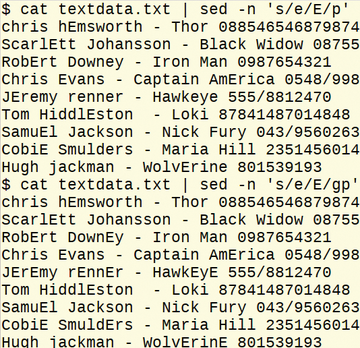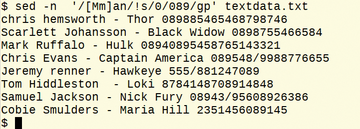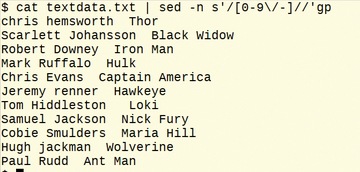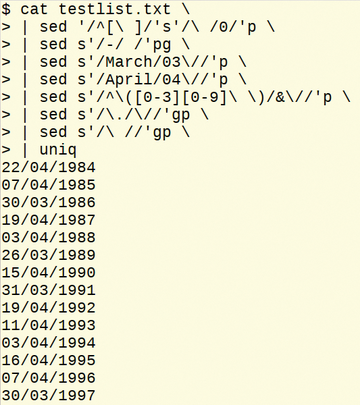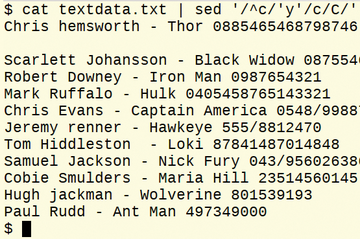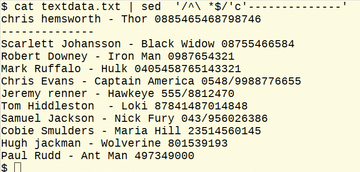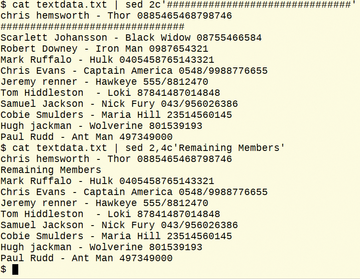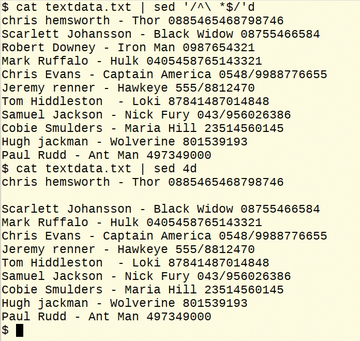« Previous 1 2 3 4 Next »
Shell practice: Introduction to the sed stream editor
Quick Edit
Searching
The search function, among other things, can be used to replace text sections, in which the search query represents the addressing. You can also use regex for search patterns. Table 5 shows some of the possibilities, with some examples in Table 6, and Figures 2-7 show some of the results. In these tables, sed both pipes in a data stream and directly accesses a text file.
Table 5
Patterns and Addressing
| Action | Pattern |
|---|---|
| All lines | (null) |
| Line 25 | 25
|
| Not line 25 | 25!
|
| Lines 10 through 20 | 10,20
|
| Last line | $
|
| Not pattern | '/PATTERN/!'
|
| Character at beginning of line | ^CHAR
|
| String | /STRING/
|
| Character set | [CHARS]
|
| Any character | [:alpha:]
|
| Lowercase | [:lower:]
|
| Uppercase | [:upper:]
|
| Alphanumeric | [:alnum:]
|
| Digit | [:digit:]
|
| Hexadecimal digit | [:xdigit:]
|
| Tab and space | [:blank:]
|
| Space | [:space:]
|
| Control character | [:cntrl:]
|
| Printable characters (no control characters) | [:print:]
|
| Visible characters (without spaces) | [:graph:]
|
| Punctuation | [:punct:]
|
Table 6
Sample Searches and Patterns
| Search for | Pattern | Example | Figure |
|---|---|---|---|
| Term, Name | '/TERM/'
|
cat textdata.txt | sed -n '/Evans/p'
|
– |
| All lines containing 'man' or 'Man' | '/[Mm]an/p'
|
sed -n '/[Mm]an/p' textdata.txt
|
2 |
| All lines except 3 through 5 | '3,5!'
|
sed -n '3,5!'p textdata.txt
|
3 |
| All lines except those containing 'Man' | '/Man/!'
|
sed -n '/Man/!'p textdata.txt
|
4 |
| Lines containing 'H' or 'G' | '/[H|G]/'
|
sed -n '/[H|G]/'p textdata.txt
|
– |
| Lines not containing 'H' or 'G' | '/[H]\|[G]/!'
|
sed -n '/[H]\|[G]/!'p textdata.txt
|
5 |
| Line 3 | 3
|
cat textdata.txt | sed -n '3p'
|
– |
| Last line | '$p'
|
cat textdata.txt | sed -n '$p'
|
– |
| Multiple patterns: Do not output lines containing an 'R' somewhere and an 'M' somewhere else | '/[R]./,/[M]./!'
|
sed -n '/[R]./,/[M]./!'p textdata.txt
|
6 |
| All lines containing some alphanumeric characters (i.e., not all spaces) | '/[:alnum:]/'
|
cat textdata.txt | sed -n '/[:alnum:]/'p
|
7 |
 Figure 7: Output all lines that contain alphanumeric characters (no empty lines or lines containing only spaces, tabs, etc.).
Figure 7: Output all lines that contain alphanumeric characters (no empty lines or lines containing only spaces, tabs, etc.).
Note the output of the following command:
sed -n '/[C]/,/[c]/!'p textdata.txt chris hemsworth - Thor ... Scarlett Johansson - Black Widow ... Robert Downey - Iron Man ... Mark Ruffalo - Hulk ... Paul Rudd - Ant Man ...
Only lines that don't fall between the first occurrence of C (Chris Evans
/Cobie Smulders
) and c (Samuel Jackson
/Hugh jackman
) are output. If you reverse the letters, putting the lowercase c before the uppercase,
sed -n '/[c]/,/[C]/!'p textdata.txt Jeremy renner - Hawkeye ... Tom Hiddleston - Loki ...
you only get two lines. Everything between chris and Chris (inclusive), between Jackson and Cobie (just those lines), and between jackman and EOF are suppressed.
If you want be absolutely certain that sed is doing what you want, you can combine several simple calls with pipes. The following command suppresses empty lines and lines with Man (Figure 8):
cat textdata.txt | sed -n '/[:alnum:]/'p | sed -n '/Man/!'p
Substituting and Removing
With the s command, you can replace matched expressions. The length of search-and-replace strings is irrelevant. The detailed syntax is shown in Figure 9.
You can limit the search and replace statement to specific lines by preceding the command with the line number, as shown here:
sed -n '5s/OLD/NEW/p' [TEXTFILE]
Or, for a range of lines, use:
sed -n '1,4/OLD/NEW/p' [TEXTFILE]
You can also suppress changes to certain lines using the exclamation mark:
sed -n '20-80!s/OLD/NEW/p' [TEXTFILE]
Furthermore, you can limit changes to lines that contain certain strings or patterns that are not the same as those used for the search-and-replace statement,
sed -n '/[STRING|PATTERN]/s/OLD/NEW/gp' [TEXTFILE]
and you can delete the matched string with an empty string.
The first occurrence of the search string on a line is processed. To replace all instances, add the g (greedy) option at the end of the statement. The stream editor can be a silent partner if the -n option is set, so if you want to see what's going on, add the p (print) option. You can also write results to an output file with w (write). Table 7 shows some short examples.
Table 7
Sample Search and Replace
| Action | Example | Figure |
|---|---|---|
| Replace pattern at the first occurrence only | cat textdata.txt | sed -n 's/e/E/p'
|
10 |
| Replace pattern at every occurrence | cat textdata.txt | sed -n 's/e/E/gp'
|
10 |
| Delete the word 'Man' | sed -n 's/Man//gp' textdata.txt
|
11 |
| Replace 'Iron' with 'Tin' on line 4 | cat textdata.txt | sed -n '4s/Iron/Tin/gp'
|
12 |
| Replace '0' with '089' on all lines containing 'Man' or 'man' | sed -n '/[Mm]an/s/0/089/gp' textdata.txt
|
13 |
| Replace '0' with '089' on all lines except those containing 'Man' or 'man' | sed -n '/[Mm]an/!s/0/089/gp' textdata.txt
|
14 |
| Delete all numbers and slashes (/ ) and hyphens (- ) | cat textdata.txt | sed -n s'/[0-9\/-]//'gp
|
15 |
The more complex example in Figure 16 converts the inconsistently formatted date syntax in the testlist.txt file to a common, unified (European) date format DD/MM/YYYY
. Be sure to press Enter immediately after the backslash at the line's end. Alternatively, you can omit the backslash and let the command wrap; the pipe character connects with the lines that follow; however, this results in a less readable screen display.
The list is read in the first line and the following lines each pipe their output to the next command: Take any present leading space characters and substitute the number ; replace any minus signs in dates with spaces; substitute any month written as a word with its numeric value followed by a slash; substitute any two-digit number at the beginning of a line (^), 0 through 3 and any digit, and any space character with "itself" (&) followed by a slash.
To make the search pattern repeatable during the replacement, enclose it in parentheses – which you have to be sure to escape with \. The final sed statements delete all existing space characters (through s command's option g).
The uniq command on the last line ensures that all duplicate lines are uniquely output. You can also "carry over" all or part of the original string into the replacement patterns in the replacement statement. Check out the following example:
echo "happy" | sed -n s'/happy/un&/'p
This example replaces happy with unhappy . You can also convert characters from lowercase to uppercase:
cat textdata.txt | sed -n s'/\([[:lower:]]\)/\U&/'pg
The \U before the & indicates the output must be converted into uppercase. You can do the following:
cat textdata.txt | sed -n s'/\([[:upper:]]/\L&/'pg
to convert from uppercase to lowercase.
Character Replacement
For character filtering, use the y option. The pattern should contain all the characters that need to be replaced, and the replacement statement should have the same number of characters. The command structure should only have s, and -n should be omitted:
sed y'/[Search CHAR]/[Replacement CHAR]/'
Substitute the first character of only the lines in textdata.txt that begin with lowercase c
with uppercase C
(Figure 17).
You use c to replace entire lines,
sed 'PATTERN'c'REPLACEMENT'
or like this:
sed [LINE(n)] c'REPLACEMENT'
The example in Figure 18 replaces an empty line with a series of dashes.
In place of a search pattern, you can use line numbers. Be aware that even if you specify multiple line numbers they will all be replaced by a single instance of the replacement string. If you choose three lines, for example, it will look like the first line is replaced and the second and third lines are deleted.
The top example in Figure 19 replaces the blank line with a series of hash marks. The bottom example removes lines 2 through 4 and inserts a given line of text.
The d option deletes lines that match a pattern or line numbers:
sed '/PATTERN/'d sed [LINE(n)]d
Using the commands in Figure 20, you can search for and delete an empty line and then delete the fourth line.
« Previous 1 2 3 4 Next »
Buy this article as PDF
(incl. VAT)
Buy ADMIN Magazine
Subscribe to our ADMIN Newsletters
Subscribe to our Linux Newsletters
Find Linux and Open Source Jobs
Most Popular
Support Our Work
ADMIN content is made possible with support from readers like you. Please consider contributing when you've found an article to be beneficial.








